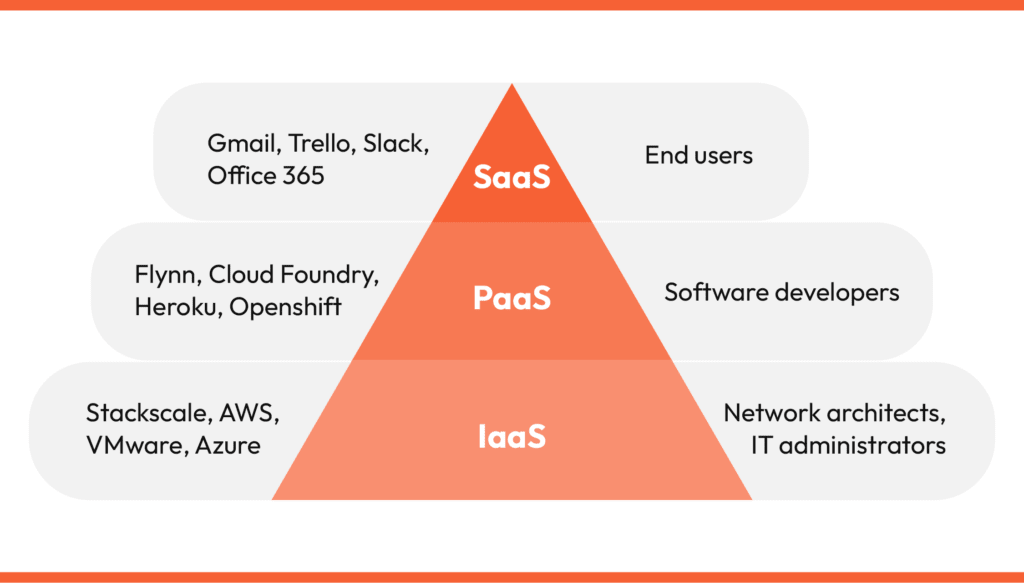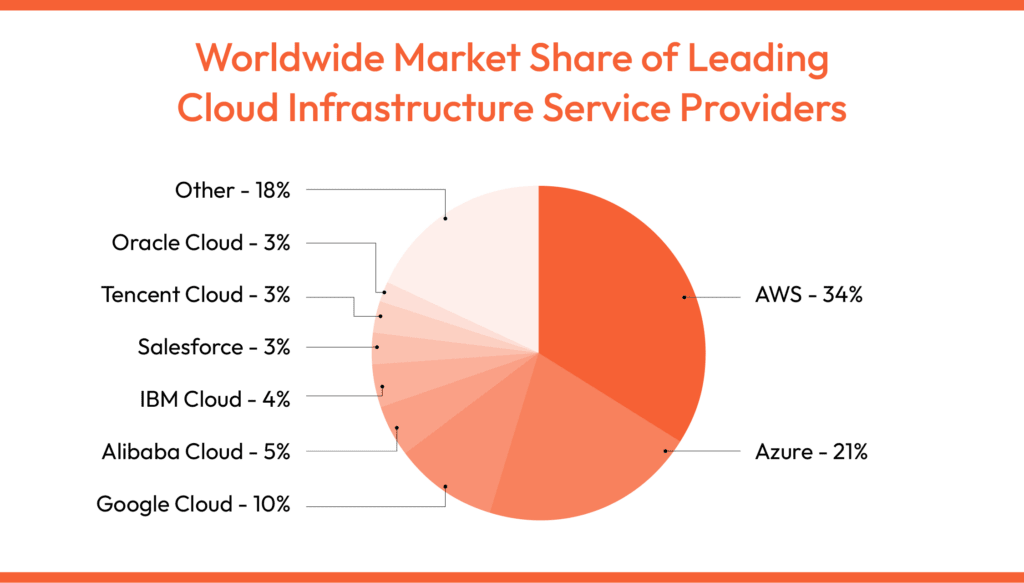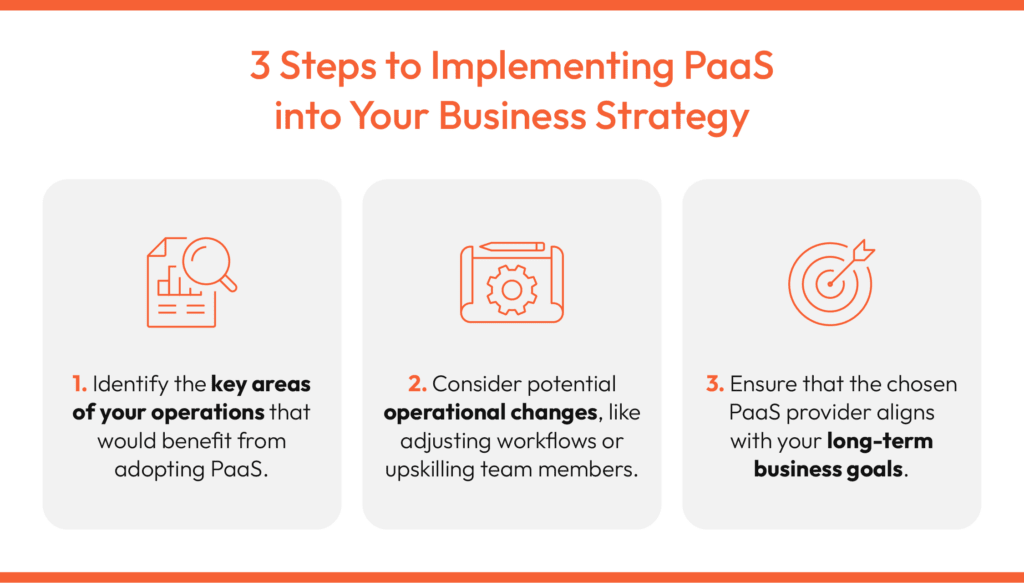In layman’s terms, PaaS is essentially a cloud computing model that provides developers with the resources they need to build and deliver applications over the internet.
Think of it like this: instead of buying all the ingredients to bake a cake from scratch, you opt for a pre-packaged mix where all you have to do is add water and eggs. Voila! Similarly, PaaS provides developers with ready-to-use computing platforms that include an operating system, database, web server, and programming language.
This means they can focus on creating their application without worrying about setting up or managing the underlying infrastructure (which can be quite tedious, if we do say so ourselves).
To put it in more technical terms, PaaS falls under the umbrella of cloud computing services alongside Software as a Service (SaaS) and Infrastructure as a Service (IaaS).

Examples and users of different cloud computing services
Differentiating PaaS from SaaS and IaaS
Let’s start with Software as a Service (SaaS). This is akin to ordering a ready-made cake from a bakery. Everything is prepared for you—all you need to do is consume it (or in this case, use the software). The provider handles everything: infrastructure, platform, and application. Examples include Google Workspace or other comprehensive solutions that require nothing more than an internet connection and a device to access them.
Infrastructure as a Service (IaaS), on the other hand, is like buying all the ingredients for your cake but making it in someone else’s kitchen. You’re given raw resources such as storage space or virtual machines; how you use them is up to you. Providers like Amazon Web Services or Microsoft Azure offer these services—they maintain the hardware while you take care of everything else.
Then we circle back to Platform as a Service (PaaS). It’s like having the oven preheated, the baking tools laid out, and some ingredients mixed already. You just have to add your secret ingredient (your code) and bake your cake (build your app). It offers more control than SaaS but less responsibility than IaaS.
If you want to know more about each, take a look at this video, where Saas, PaaS and IaaS are explored in detail.
An example of our experience in SaaS projects can be illustrated with the following case. One of our clients provides software for real-time inventory management and integration with accounting and e-commerce platforms. They contacted us requesting a transformation of their platform. We deployed a team of 12 engineers to transform it into microservices, enabling full integration with third-party software like Amazon’s API. This swift and expertly executed project allowed the client to launch their SaaS version, enhance their product, and meet deadlines with ease.
Components of a Typical PaaS Model
Let’s now dissect the anatomy of a typical PaaS model.
First, we have the runtime environment. This is where your application lives and breathes. It’s like the stage for a play—all the action happens here.
Next up are the development tools. They’re what you use to create and shape your application. They can be programming language support (Java, Python, etc.), databases, or design tools.
Then there’s middleware. If our PaaS model was an orchestra, middleware would be the conductor—it ensures all parts work together harmoniously. Middleware handles tasks such as session management, caching, and messaging systems.
Finally, we have infrastructure services like storage and networking. Think of these as the backstage crew in our theatrical analogy—they may not be visible to the audience (users), but without them, there’d be no show at all.
Now let’s put this into perspective with an example: Heroku is a popular PaaS provider that offers these components. When we use Heroku to deploy an app, we don’t worry about managing servers or setting up networks; instead, we focus on writing code using their provided development tools. The runtime environment is pre-configured and ready to host our app, while middleware ensures seamless integration between different parts of our application.
Exploring the Key Features of PaaS
First, we have scalability. This is akin to having an expandable theater; if your audience (or user base) grows, you can easily add more seats (or server capacity). The beauty of PaaS is that it can automatically adjust to meet demand, ensuring that your application’s performance doesn’t suffer, even during peak times.
Second, there’s the aspect of cost-effectiveness. With PaaS, you’re essentially renting a stage instead of building one from scratch. You only pay for what you use (like how you’d only rent enough seats for your audience), which makes it a cost-effective solution, especially for startups and small businesses.
Third, we have rapid deployment. It allows developers to quickly deploy their applications without worrying about infrastructure setup or maintenance.
Finally, let’s not forget about collaboration. With PaaS, multiple developers can work on the same project simultaneously (much like how a group of actors rehearse together), improving productivity and efficiency.
Are you interested in knowing how PaaS technology fits your business needs? Request a call for a free consultation.
Types of PaaS: Private, Public, and Hybrid
- Private PaaS. This type is akin to having your own private theater where you have complete control over the environment. It’s hosted on your own infrastructure and provides an additional layer of security. However, it requires more resources to manage and maintain—so be prepared for some heavy-duty stage management.
- Public PaaS. This one’s like performing at the town square where everyone has access to watch your show. It’s hosted on the provider’s infrastructure, which means they handle all the technical aspects (the stage setup, lighting adjustments, crowd control). It’s cost-effective but less secure—so keep an eye out for any potential gate crashers!
- Hybrid PaaS. This is a blend of both worlds. Imagine performing in a theater with retractable walls; you can open them up when you want to let the public in or close them when you need privacy. In technical terms, sensitive operations are run on private servers while other tasks are handled by public ones.
The Relevance of PaaS in Business Operations
PaaS simplifies the development process, which can be quite a boon for businesses. Instead of having to worry about infrastructure setup and maintenance (a headache we’d all like to avoid), businesses can focus on developing applications that directly contribute to their bottom line.
Let’s take an example of a retail business looking to expand its online presence. With PaaS, they can quickly develop and deploy an e-commerce application without worrying about server capacity, security updates or software patches (those pesky little things that always seem to pop up at the most inconvenient times). This way, they can devote more time and resources toward enhancing user experience and expanding their product range—tasks that directly impact revenue generation.
Benefits and Limitations of Implementing PaaS
With PaaS, we can significantly reduce the time taken to develop and deploy applications. It’s like having an express lane on the highway of software development—no traffic jams or red lights to slow us down. Furthermore, PaaS offers scalability that is both cost-effective and efficient.
However, despite these considerable benefits, there are also limitations to consider when implementing PaaS. One significant drawback is vendor lock-in; switching providers can be as challenging as trying to change trains in the middle of a tunnel.
Also, while PaaS offers impressive automation capabilities, this may limit customization options. It’s akin to ordering from a set menu at a restaurant—sure, it simplifies decision-making, but forget about asking for extra cheese on your pasta.
Then there is also the learning curve; it may sound nice to have all your infrastructure in one place, but there is a very good reason why companies like Amazon and Microsoft are constantly offering workshops and certifications for managing the dashboards of their product (tip: It’s complicated).
PaaS Providers: Who Rules the Market?
Now that we’ve delved into the mechanics of PaaS and its transformative potential, let’s shift gears and explore the major players in this dynamic field. After all, knowing who rules the roost can help us make informed decisions (and keep us from backing the wrong horse).

Source: Statista
First up is Amazon Web Services (AWS) Elastic Beanstalk. This titan needs no introduction, as it’s widely recognized for its comprehensive suite of services. AWS Elastic Beanstalk simplifies the process of deploying and running applications by handling all those pesky details like capacity provisioning, load balancing, and automatic scaling.
Next in line is Google App Engine, another heavyweight contender. This PaaS offering lets developers build highly scalable applications on a fully managed serverless platform. It’s like constructing a skyscraper, with an army of robots doing all the heavy lifting!
Microsoft Azure also deserves a mention here, with its robust PaaS capabilities catering to a variety of programming languages and tools.
Last but not least, there’s IBM Cloud Foundry, which offers high-productivity developer experience based on popular open-source projects.
So, there you have it—our top contenders in the PaaS arena! But remember folks: while these providers may rule the market today, technology is an ever-evolving beast. Always keep an eye out for emerging players who might just shake things up!
Selecting the Right PaaS Provider: Key Factors to Consider
When we select a PaaS provider, we need to consider several key factors.
First, we must examine the programming languages and frameworks supported by the provider—you wouldn’t want to find yourself without support for your preferred language or framework!
Second, we need to assess scalability and load-balancing capabilities. Imagine hosting a party where guests keep pouring in; you’d want your home (or in this case, your platform) to accommodate everyone comfortably and ensure no one is left waiting at the door (or worse, crashes the party!).
Third, we must evaluate integration capabilities with existing systems and tools. It’s essential that our chosen PaaS integrates seamlessly with our current tech stack.
Finally, security measures are crucial. Most Market Leaders offer similar solutions, but their policies surrounding responsibility are slightly different, so it’s a good idea to review their documentation and pick a solution that aligns with your own values and perspectives.
Remember this though: while these factors are important, they aren’t exhaustive. Every organization has unique needs and circumstances. So, make sure you tailor these considerations according to what best suits your organization’s requirements.
In essence, integrating PaaS into your business strategy is about more than just technical compatibility; it requires strategic planning and thoughtful execution.
10 Detailed PaaS Examples That Did Things Right
And if you are looking for more great PaaS examples, well then look no further.
Heroku
As one of the pioneering cloud platforms, Heroku is a Platform as a Service (PaaS) that allows developers to build, run, and manage applications entirely in the cloud. Supporting various programming languages like Ruby, Java, PHP, Python, Node.js, Scala, and Clojure, Heroku is renowned for its simplicity and seamless deployment process, making it a favorite among startups and individual developers.
Google App Engine
Google App Engine enables developers to build and scale web applications and mobile backends on Google’s robust infrastructure. Supporting popular languages like Java, PHP, Node.js, Python, C#, .NET, Ruby, and Go, as well as custom runtimes and frameworks, App Engine offers automatic scaling capabilities, dynamically adjusting resources based on your application’s traffic demands.
Microsoft Azure App Service
As part of Microsoft’s cloud offering, Azure App Service is a fully managed Platform as a Service (PaaS) that empowers developers to rapidly build, deploy, and scale web applications and APIs. Supporting a diverse array of programming languages like .NET, .NET Core, Java, Ruby, Node.js, PHP, and Python, it provides robust features such as security, load balancing, autoscaling, and automated management, streamlining the development process.
AWS Elastic Beanstalk
Amazon Web Services’ Elastic Beanstalk is a Platform as a Service (PaaS) solution that streamlines cloud application deployment and management, abstracting away infrastructure concerns. Developers can simply upload their code, while Elastic Beanstalk automatically handles deployment, capacity provisioning, load balancing, auto-scaling, and application health monitoring. It supports a range of programming languages and frameworks, including Java, .NET, PHP, Node.js, Python, Ruby, and Docker, facilitating a hassle-free development experience.
IBM Cloud Foundry
IBM Cloud Foundry is an open-source Platform as a Service (PaaS) that provides developers with a choice of cloud services and frameworks. Supporting multiple programming languages, services, and integrated DevOps, it enables developers to build, run, deploy, and manage applications on the cloud efficiently. Designed to facilitate rapid cloud-native application deployment, IBM Cloud Foundry empowers developers with a streamlined and flexible development experience.
Red Hat OpenShift
OpenShift, a containerization software suite developed by Red Hat, is an open-source Platform as a Service (PaaS) that equips developers with tools to build, deploy, and manage applications on cloud infrastructure. Built around Docker containers orchestrated by Kubernetes on a Red Hat Enterprise Linux foundation, OpenShift supports multiple languages and frameworks. Designed for scalable, secure, and flexible applications, it offers a robust environment for containerized application development and deployment.
SAP Cloud Platform
SAP Cloud Platform (SCP) is SAP’s Platform-as-a-Service (PaaS) offering, providing a comprehensive suite of services for application development, integration, and extension. This cloud-based platform offers tools to integrate and enhance SAP applications, build new solutions, and leverage cutting-edge technologies like the Internet of Things (IoT), machine learning, and analytics. Designed to empower businesses, SCP enables the building and extending of applications within SAP’s secure cloud environment, fostering innovation and agility.
Oracle Cloud Infrastructure (OCI) Application Development
As part of its Oracle Cloud Infrastructure, Oracle provides a Platform-as-a-Service (PaaS) solution geared towards application development. This platform equips developers with tools to build, deploy, and manage applications in the cloud environment. Supporting various programming languages and frameworks, it offers services such as Oracle Autonomous Database, Oracle Container Engine for Kubernetes, and Oracle Functions – a serverless computing service. Oracle’s PaaS empowers developers with a comprehensive toolset for cloud-based application development and management.
Pivotal Cloud Foundry (PCF)
Now part of VMware Tanzu, Pivotal Cloud Foundry is an open-source Platform as a Service (PaaS) designed to accelerate and streamline software delivery. This cloud platform enables developers to build, deploy, and scale applications seamlessly while supporting multiple programming languages and services. With its cloud-native infrastructure and comprehensive framework, Pivotal Cloud Foundry empowers developers to create web and mobile applications rapidly and reliably.
Engine Yard
Engine Yard is a Platform as a Service (PaaS) that specializes in automating application deployment and management in the cloud environment. Offering managed environments for programming languages like Ruby on Rails, PHP, and Node.js, Engine Yard emphasizes its automation and management tooling. These tools enable developers to rapidly deploy applications and effortlessly manage them, prioritizing high performance and scalability throughout the application lifecycle.
Conclusion: Is PaaS the Right Solution for You
Well, we’ve reached the end of our 101. We’ve explored the nooks and crannies of PaaS, its symbiotic relationship with SaaS and IaaS, and how it plays a crucial role in the cloud computing triumvirate. But now comes the million-dollar question: Is PaaS the right solution for you?
If you’re a business looking to enhance your team of eager developers through staff augmentation, aiming to create bespoke applications without the hassle of managing infrastructure (like servers and storage—all that technical jazz), then PaaS might just be your knight in shining armor.
However, if you prefer more control over your infrastructure or have highly specialized requirements that off-the-shelf solutions can’t meet, then perhaps IaaS or traditional on-premises development would be more up your alley.
So, there we have it! We hope this exploration into PaaS has been enlightening and helps guide your decision-making process. Remember, every business is unique—just like our taste in humor—so choose wisely! Until next time, keep those geek glasses polished and ready for action.







